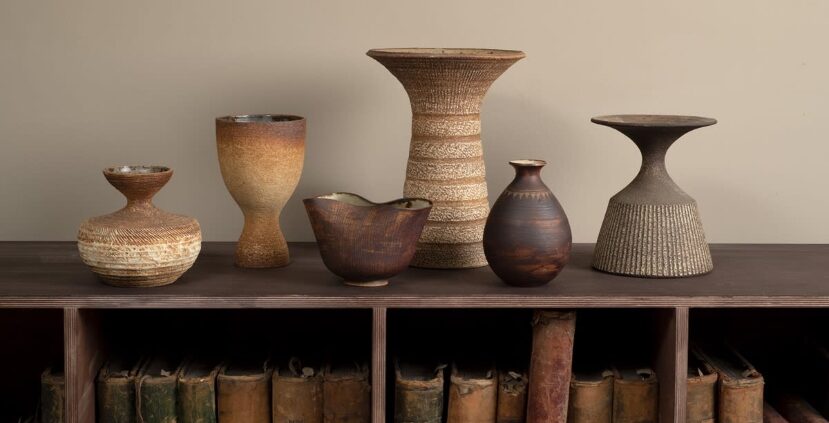
The mysterious sophistication of an art gallery is inevitable. The echoing click-clack of heeled boots on hardwood floors making you regret your shoe choice, the quiet whispers of art lovers lingering in the air. The said mysterious sophistication was apparent in The Fine Art Society, who hosted a pottery exhibition by Waistel Cooper, proving the importance of ceramics in art.
The Fine Art Society opened its’ doors in London and Edinburgh this February to showcase the work of a pottery pioneer Waistel Cooper. With 2021 marking a century since Cooper’s birth, it was time to celebrate the life and work of the famous potter. The art exhibition was significantly sourced by Waistel’s life-long friend and her daughter in Edinburgh, with the combined collection of over a hundred pieces of the artists’ ceramics. Visitors also had the opportunity to not only observe the exhibition, but also to purchase modern art pieces that sparked interest or inspiration.

The Fine Art Society was established in 1876 with galleries in both London and Edinburgh. As one of the oldest fine art dealers in the UK with a reputable influence in the market, the art galleries continue to present some impressive names, with James McNeill Whistler, Alfred East, and Alexander Naysmith being just a few examples. The Fine Art Society continues to be a leader in Scottish art from the 1700s and British art from Victorian, Edwardian, and interwar periods.
The main aim of the exhibition was to bring Waistel Cooper’s work back into focus. Ever since his death in 2003, modern literature fails to mention the existence of the potter. Evidently, the name Waistel Cooper should be amongst the revolutionary artists, such as Hans Coper and Lucie Rie. Waistel’s uniqueness manifested in his ceramics with a rough-textured and sculptural style that was so much more than just a pretty pot. Thus, the potter’s work has been recognised and showcased parallel to the aforementioned famous names early on in his career.

“I think he was ahead of Coper and Rie in terms of success. While they we still making domestic stuff like tableware to make a living, Waistel Cooper was able to create purely decorative ceramics.” Says Emily Walsh, managing director of The Fine Art Society.

Moreover, no book has ever been published on Waistel Cooper or his work. It is time the famous potter’s work is revaluated and recognised in the company of the greatest British artists in the history of modern art.
The exhibition chronologically follows Waistel’s life work by starting with the 1940s. After the Second World War, Cooper moved to Iceland and the native influences are clearly notable in his earlier work. Described as ‘from another world’, the ceramics were decorated with mystical dancing creatures and symbols. Waistel was also inspired by the volcanic landscape of Iceland and successfully experimented with volcanic rock and clay.

In the wake of the peak of Cooper’s career, he moved back to England in 1950. Emily Walsh describes the 50s as her personal favourite period of Waistel’s work. However, the 60s was when the artist found his definite form and voice. Furthermore, the exhibition is finalised with light pastel coloured stoneware vases from the 80s.
Evidently, the artist sought inspiration from diverse places: flora and fauna of the English landscape, spirituality brought on by his second wife, and the secrets of Icelandic folklore. ‘They [the pieces] all got something slightly different about them.’ The influences of different aspects and the evolution and growth of Waistel seen through his work tells a story of travel, love, sorrow, and even of the metaphysical. Therefore, the art exhibition has shown how there is so much more to pottery than meets the eye and has proven Waistel Cooper should be uplifted in the pantheon amongst other great artists.

The Fine Art Society will also be hosting a second exhibition showcasing more of Cooper’s pots later in the year. What is more, visitors wishing to pop in while in London or Edinburgh can always find an exhibition going on with a busy programme for the rest of the year. For example, the gallery will be presenting paintings by John Byrne from the 23rd of May, who is a successful Scottish artist.
A Scottish landscape painting exhibition by the influential Alexander Naysmith will also be held in autumn. Emily Walsh says ‘we’ve got some beautiful work by Naysmith and his family. Some people might consider this kind of exhibition old-fashioned, but they are just the most beautiful, atmospheric paintings.’ Sometimes, old is better than new: the paintings have lasted 200 years, and they will last 200 more.

Finally, for the people who do not consider themselves art gurus but are intrigued by the idea of becoming more familiar with fine art, got some advice from Emily. ”Go to a local gallery and see what kind of art you want to spend time in front of. Just keep looking – when you see new art all the time, you start recognising things, you’re refining and learning more about it. It cannot be rushed.” The good things in life cannot be rushed, and art is no exception.

